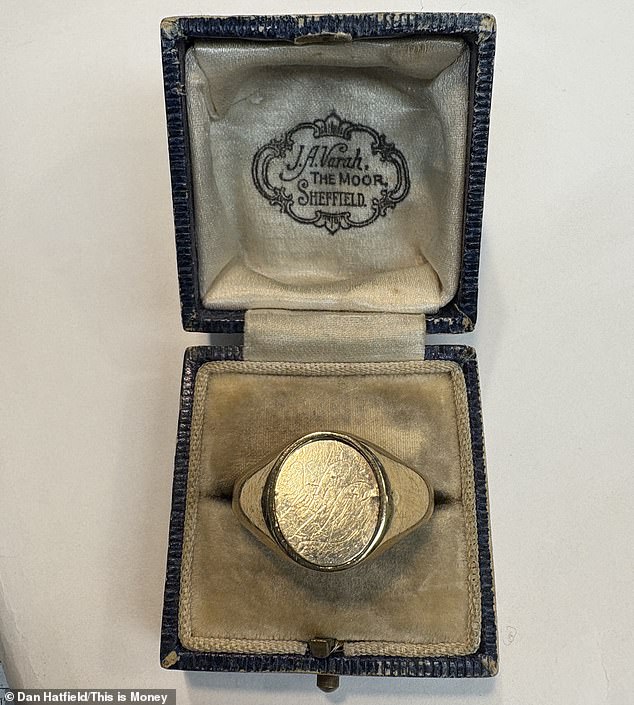While clearing out my recently deceased Dad’s home we came across this ring.
After a little search we discovered that the symbol is for the Freemasons.
We now believe our dad was a secret Freemason and wondered if his mysterious golden ring is worth a fortune.
We have never come across one like this before. We have weighed it and it comes in at 7.9 grams. Christine, via email.

Gold ring: It’s a chunky piece of jewellery, hiding a secret…
SCROLL TO THE BOTTOM TO FIND OUT HOW TO GET YOUR MODERN TREASURE VALUED BY DAN
Dan Hatfield, resident This is Money expert valuer, replies: As a self-proclaimed aficionado of secret societies, I couldn’t resist the allure of appraising your Freemasons ring that recently graced my inbox.
The Freemasons – a fraternity steeped in secrecy – have always intrigued me with their clandestine handshakes, ceremonial regalia, and, let’s not forget, those intriguingly rolled-up trousers.
It’s a world that straddles the line between the fascinating and the faintly comedic.
Tracing their origins back to the Middle Ages, the Freemasons began as guilds of stonemasons, the master builders of their time.
These craftsmen were the brains and brawn behind the towering cathedrals and expansive universities that dotted the landscape.
The guilds served not only to regulate the qualifications of those wishing to practice the craft but also to manage interactions with authorities and patrons.
Over the centuries, the Freemasons broadened their membership criteria, evolving into a fraternity where you’re as likely to encounter a high court judge as you are a local butcher.
The modern version of the Freemasons is a diverse group of people (you have to be male to join Freemasonry but there are women’s Grand Lodges that are separate from the men’s lodges) with a commitment to mutual support, integrity, charitable endeavours, and societal improvement.
Some members even liken it to an archaic version of Facebook – a platform for networking and camaraderie.
Despite these noble principles, public perception of the Freemasons often veers toward suspicion.

It swivels: This then shows of a blue enamel face with a square and compass
The 15th century saw the emergence of certain rituals, which further evolved during the 17th and 18th centuries, adding layers of mystique to the fraternity.
The symbolism of King Solomon’s Temple forms the cornerstone of Masonic tradition, and while the organization isn’t a religion, it does require a belief in a higher power.
Lodges convene quarterly to induct new members, ceremonies enveloped in an aura of mystery and secrecy.
Freemason jewellery truly came into prominence during the Victorian era, with enamel work being a standout feature.
A notable aspect of such pieces was their ability to discreetly conceal their Masonic affiliation – a nod to the organisation’s penchant for secrecy.
I see from your photos that your ring has that rather interesting feature.
Your ring prominently displays the iconic square and compass, symbolizing morality and moderation.
The vibrant blue enamel, often susceptible to chipping over time (which can significantly diminish value), remains remarkably intact on your piece – a testament to its preservation.
If you think about it, most Freemasons would have spent most of the time wearing the enamel finger down, to hide their affiliation but when swivelled it would reveal a plain signet-style face.
Yours has minor scratches but I’m confident these can be easily polished out.
While swivel rings gained popularity in the Victorian era, the design and hallmark of yours suggest a more contemporary origin.
Although the date mark isn’t visible in your photo, I’d estimate it hails from the late 1980s.
Despite public suspicion, Freemason jewellery enjoys considerable demand.
With over 200,000 members in the UK and millions globally, there’s a dedicated market of enthusiasts with disposable income, passionate about Masonic artifacts.
This niche, yet fervent, market often proves more lucrative than a broader, indifferent audience.
Moreover, interest isn’t confined to members alone; there’s a notable appetite for such jewellery across Europe and particularly in America.
Your ring’s substantial weight of 7.9 grams and its 9ct (37.5 per cent pure) gold composition mean its intrinsic gold value is around £215, especially considering that gold prices have surged by nearly 40 per cent since January 2024.
However, the desirability of Masonic jewellery ensures its value far exceeds mere scrap.
Based on similar pieces I’ve come across; I would comfortably value your ring between £550 and £600.
BUT, with gold prices increasing and estimates from some of the world’s leading figures believing that gold could continue to grow sharply in the years to come I would strongly advise not to sell just yet, unless the money is needed right now.
On top of this, I also think there will be an increase in demand for Freemason items in the future due to their current popularity.
This has been such an intriguing item for me to value and a captivating journey through history, so thank you.
Some links in this article may be affiliate links. If you click on them we may earn a small commission. That helps us fund This Is Money, and keep it free to use. We do not write articles to promote products. We do not allow any commercial relationship to affect our editorial independence.
This article was originally published by a www.dailymail.co.uk . Read the Original article here. .


